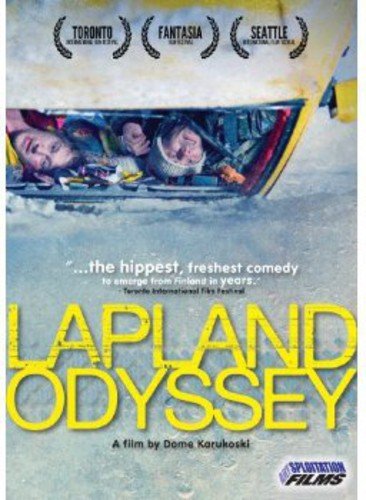
Directed by Finnish filmmaker Dome Karukoski, Lapland Odyssey is a pretty standard guy movie wrapped up with a cute bow. It features most of the genre’s clichés, including the “endearing” band of underdogs, the blistering and “too-serious” girlfriend, the wild supporting characters, the nudity, and the violence against reindeer.
Karukoski directs a Pekko Pesonen screenplay, marking the second pairing between filmmaker and writer. The first was 2005’s Beauty and the Bastard. 2010’s Lapland Odyssey has its heart in the right place, describing a tale that seems at least somewhat based in the economic and social realities of its lead characters, but it’s hard to describe this 2010 flick as anything more than a rather middling affair.
The film opens with a narrator telling us about a dead pine tree in Finland’s Lapland province. It’s a bit of a suicide hotspot, illustrating the bleakness felt in the region. We then zero in on Janne (Jussi Vatanen), a slacker if there ever was one. When his girlfriend (Pamela Tola) gives him cash to buy a digibox for their television set, Janne spends it on booze and hangs out with his friends.
The trouble is that Janne was initially supposed to get the digibox, essential for viewing Finland’s all-digital programming, three years ago. His girlfriend is rightly pissed off and gives him an ultimatum: get the damn thing tonight or the nine-year relationship is over. Janne sets out with Kapu (Jasper Pääkkönen) and Tapio (Timo Lavikainen) to try to get the digibox in time.
While some of the film tries to suggest that the three main characters are victims of the economy (the booklet suggests there are areas in Lapland where unemployment is over 40 percent), it does appear that the men are living in the respective beds they made. When one character is offered a job by the movie’s “villain” (Kari Ketonen), he turns it down because he prefers to spend time on his hobbies.
Lapland Odyssey‘s insistence on sprinkling its more unusual wit with moments of wholesomeness overturns the narrative thrust. Some scenes drift like something out of Fargo, while the slow absurdity of the Swedish underwater rugby team sequence plunges its teeth into gentler Animal House terrain.
Inari’s scenes with her ex-boyfriend feel like excuses to add tension and an easy heavy, furthering Lapland Odyssey‘s dependence on clichés. And wild sequences involving Russians and reindeer only further the film’s purposeless appeal, providing a few giggles and little else to get us closer to the characters.
The comedy of Karukoski’s picture is a matter of taste. It isn’t a particularly bawdy film and it plays things pretty close to the chest, gliding away from unpleasantness and vulgarity in favour of a comparatively courteous course. There is a sense that this picture, for all its doggedness with respect to Finnish realism, is a touch too careful.
There is little here that audiences will not have seen elsewhere. Despite Karukoski’s skill as a director (and Pini Hellstedt’s crisp cinematography), this is a film that simply exists without much by way of vitality or enthusiasm. Lapland Odyssey isn’t a dreadful picture by any extent, but it’s also not a very notable one.
The DVD release from Artsploitation Films includes an eight-page booklet that features an interview with Karukoski. There’s also a set of trailers, including one for Gandu, and a presentation of Karukoski’s short Burungo.